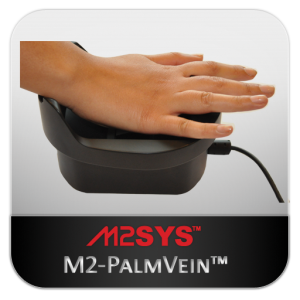Palm vein biometrics uses near-infrared light to create a “vein map” of a patient’s palm which is then linked to their unique electronic medical record. Using RightPatient® with a palm vein recognition reader, patients provide their date of birth, scan their palm, and the system automatically pulls up their electronic medical record.
100% safe. The “near-infrared” light used in the palm vein recognition scanner is the same technology used in everyday items, like your TV remote control. Palm vein biometrics has been tested and certified to be safe for use in healthcare as a patient identification tool.
Security – Palm vein biometric patterns are difficult to forge. Because palm vein patterns exist inside of the body, it is practically impossible to recreate someone’s biometric template. The palm vein recognition sensor needs the hand and blood flow to register an image.
Usability – The palm vein biometrics reader is relatively easy for patients to use. They simply place a flattened hand on the palm vein hand guide and spread out their fingers. The palm vein sensor then captures the biometric image.
User Acceptance – Customers using palm vein biometrics for patient identification typically have a high level of patient acceptance. The technology carries a low social stigma.
Increasing patient data integrity – Many healthcare facilities are turning their attention to using biometrics for accurate patient identification ensuring the data they link to their EHR systems is attributed to the correct patient. Using palm vein biometrics for patient identification at appropriate patient care touch points strongly supports healthcare patient identification protocols and helps to meet required regulatory initiatives set forth by agencies like The Joint Commission.
Elimination of duplicate medical records and overlays – Through the use of palm vein biometrics for accurate patient identification RightPatient®links a patient’s unique biometric profile to one electronic medical record and eliminates the creation of duplicate medical records and overlays.
Improves revenue cycle management – Duplicate records jeopardize patient safety by giving healthcare providers an incomplete view of a patient’s medical history, thereby increasing the chances of medical error however, the negative effect of a high duplicate record rate on the revenue cycle is not widely recognized. Duplicate records have the potential to affect a number of downstream financial activities and other key initiatives a hospital or health system may implement, such as the deployment of an electronic health record (EHR) or a new patient registration system.
Lowering the duplicate patient record rate by implementing the RightPatient palm vein biometrics patient identification solution increases revenue cycle management efficiency by improving the accuracy of information used to submit claims, collect payments, and provide care.



